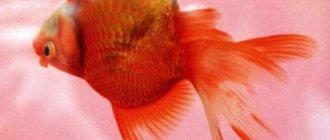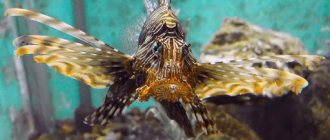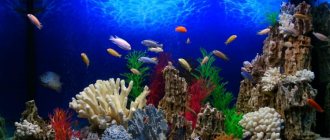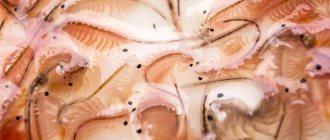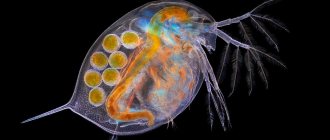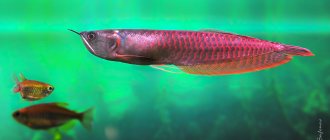In recent years, freshwater nano-aquariums have become increasingly popular. However, lovers of large fish have not disappeared anywhere. Of course, there are difficulties in keeping large or even giant fish, but they are more than compensated by the spectacle of show aquariums!
More often, such aquariums belong to aquariums and zoos, but, of course, aquariums with several tons of water are kept in apartments and country houses.
Show aquariums are a whole underwater world with very large, unusual-looking fish. Such aquariums are decorated according to the preferences of specific fish. However, one rule remains the same for all residents - any decor must be securely fastened!
The filtration of such aquariums is always at the highest level: giant fish eat a lot and excrete a large amount of waste products.
We have selected the largest and most common fish among aquarists. Their juveniles can be kept in medium-sized aquariums (for example, 300 liters), however, for full growth and development, these fish simply need large volumes!
Arapaima gigas
Arapaima is truly a freshwater giant, reaching a length of three meters! Belongs to the Arapaimidae family. In nature, it lives in the Amazon River basin. Arapaima are also the oldest fish on the planet. Their remains date back to about 15-20 million years old.
The arapaima has a highly elongated body covered with armored scales. The head is flattened, with a large mouth. The color of the fish is silver with red scales.
Arapaima have been successfully kept in captivity. The main requirement is that they need an aquarium with a volume of at least 1000 liters. They are a great option for show aquariums. You can be sure that the arapaima will amaze any observer with its grace and power!
Reproduction
Macrognathus reach sexual maturity by 2 years , but achieving offspring in an artificial reservoir is very difficult.
This is due to the peculiarities of changes in water parameters during spawning, because it occurs during the rainy season.
Read about other unusual aquarium fish:
Acanthophthalmus: an amazing fish with the body of a snake Astronotus tiger: 3 popular species and behavioral characteristics
Sex differences
It is quite simple to distinguish a female from a male: she is much larger and more plump .
Spawning
To produce offspring in an aquarium, breeders resort to hormonal injections, for example, Nerestina .
For spawning, prepare a separate reservoir with a volume of at least 200 liters and a length of 1 meter. There should be high aeration in the spawning tank, and due to a powerful filter, a fairly strong current is created.
The water hardness is reduced compared to the main tank. Breeder fish are fed high-protein food for a week.
Soil is poured onto the bottom of the spawning tank, a net is laid, shelters are installed and plants are planted:
- Java moss;
- microsorium;
- bolbitis.
The spawners are placed in the spawning tank at the moment when the female’s abdomen swells. For one female they take two males. The spawning area is shaded and the fish are left alone. Spawning lasts several hours, then the spawners are removed.
The incubation period of eggs lasts about 4 days , after another 4 days the fry become capable of independent feeding.
During the period of growth of macrognathus fry, it is necessary to regularly change the water and add antifungal drugs to the reservoir to prevent the development of fungal infections.
Giant armored pike (Atractosteus spatula)
Another freshwater giant is the armored pike, which grows up to one and a half meters! The homeland of fish is the waters of North America. The pike has an elongated, torpedo-shaped body with a mouth reminiscent of a crocodile. The color of the fish is olive-silver. The armored pike is a solitary predator, feeding on any living creature of suitable size. Looks impressive in show aquariums from 1000 liters.
Great white shark
Among the population, the white shark received other names: big shark, killer shark, carcharodon. Everything about the white shark is impressive: its strong jaws and enormous size. The great white shark is the largest inhabitant of the world's oceans (compared to other sharks) and the most dangerous predator, posing a threat to human life. The average length of representatives of the species is 4.5 m.
There is evidence that fishermen caught specimens with a body length of 6 m. The killer shark is considered an endangered species. There are only 3,500 great white sharks in the world.
High-finned pangasius, shark catfish (Pangasius sanitwongsei)
Pangasius or shark catfish is a large, spectacular freshwater fish, growing up to one and a half meters, native to Southeast Asia.
An elongated, swift body of black and silver color with high fins and a large mouth - all this makes the pangasius look like a shark!
As a rule, juveniles of these fish are kept in aquariums. They are active and mobile, get along well in a flock. Adults are calmer and more reserved and look impressive in show aquariums of 1000 liters or more with other phlegmatic predators, such as arapaima.
Akara turquoise
A miniature artificial pond is not suitable for keeping turquoise acara. The length of adult individuals is about 30 cm. Therefore, if you need to place a couple of fish, you should choose containers with a volume of more than 300 liters. It is very sensitive to water quality.
Representatives of this family come from South America. Average life expectancy is 8 years. They have an incredibly beautiful silver-gray color, bluish-green scales, located throughout the body. The unusual coloring harmoniously combines with the wide yellow edging of the fins. A distinctive feature of males is the presence of a pronounced fatty lump.
Individuals are distinguished by interesting behavior. Turquoise Akara has become famous for its increased aggressiveness. That is why its second name is “green terror”. For this reason, you should carefully select your roommates. Ideal options are sized catfish or other cichlids.
Females behave completely differently after mating; they simply amaze with their well-expressed parental instinct. They incubate the eggs in their mouths until the fry hatch. They care for the offspring until they learn to feed themselves.
Akara turquoise
Fractocephalus (Phractocephalus hemioliopterus)
Fractocephalus or red-tailed catfish is a large, bottom-dwelling fish that grows over a meter and is predominantly nocturnal. The homeland of these catfish is the Amazon River basin. Fractocephalus is incredibly voracious, its large mouth can accommodate fish similar in size to itself.
Fractocephalus has a flattened horizontal body, expanding towards the head, and sensitive whiskers on the muzzle. The coloring is attractive: black and white body with orange-red caudal and dorsal fins.
Fractocephalus is loved in home aquariums, but mostly young individuals are kept. For adult fish, a volume of 700 liters is recommended.
Flower Horn
Flower Horn is another creation of Asian breeders. But, unlike parrot fish, such pets are able to reproduce at home. This variety of cichlids simply amazes with its bright color and unusual shape. The main advantage of these is the fatty growth on the head. And the larger the rainbow horn, the more expensive the fish.
On sale you can find Flower Horns in a wide variety of colors. The scales can be pink, red or silver-gray. Irregular shiny spots are located all over the body. Males are more brightly colored than females.
The length of the giant is about 45 cm. When choosing a suitable aquarium, you should take into account that there must be at least 150 liters of water per individual. In case of group keeping, this criterion should be increased to 800 liters, since hybrids are characterized by increased territoriality and aggressiveness not only towards representatives of other species, but also relatives.
It is very easy to care for such fish. They are absolutely loyal to food and water quality. Flower Horn can live up to 10 years.
Flower
Pseudoplatystoma fasciatum
Pseudoplastoma is a large predator from the Pimelodidae catfish family, growing more than a meter in length. The homeland of fish is the waters of South America.
Pseudoplastytoma is elegant and beautiful, but it should be kept in spacious show aquariums of 700-1000 liters. The fish has an elongated, powerful body with an elongated, flattened muzzle and a large mouth. The color of pseudoplastic is gray-silver with dark spots and stripes.
Despite its gluttony and aggressiveness, pseudoplatistoma is shy in the aquarium. For the comfort of the fish, you should decorate it with grottoes and driftwood.
Pterygoplicht brocade
Pterygoplicht brocade or as it is also called catfish-prilipala is deservedly considered one of the largest representatives of its family. They grow up to 50 cm. The aquarium for their maintenance must be at least 250 liters.
Catfish grow very slowly, reaching their maximum length only after reaching the age of five. The average life expectancy is 10-15 years. Thanks to its beautiful spotted coloring, this beauty will undoubtedly become a real decoration for any aquarium. Moreover, the background color of the body can be of a wide variety of shades: golden brown, black, olive, gray, green, yellow or orange. Males are larger, brighter, and have spines on their pectoral fins.
Despite its impressive size, it is a peaceful, herbivorous creature that coexists peacefully with other fish. The brocade pterygoplichthus spends most of its time at the bottom eating algae. A few individuals will be enough to keep the aquarium clean.
Catfish are especially active at night. Therefore, it is imperative to provide shelter so that the fish can rest there during the day. Ideal options are driftwood made of natural wood.
Pterygoplicht brocade
South American arowana (Osteoglossum bicirrhosum)
Arowanas are large fish from the Bony Tongue family, growing over one meter. The birthplace of fish is the Amazon River basin.
Arowanas live under the surface of the water, hunting fish, as well as animals and birds that fall into the water. Arowanas have a highly elongated, laterally compressed body with a pointed head and a capaciously opening mouth. The large eyes of the fish are perfectly adapted for a wide view. Arowana scales are large, prominent and very decorative. The color of the fish is silvery.
Aquarists love arowanas for their ease of maintenance, interesting behavior and unusual appearance. An aquarium of 700 liters or more is suitable for them, and a mandatory condition for keeping these fish is a tight-fitting lid! Arowanas are jumping and easily “escape” from the aquarium.
Parrot fish
This is one of the most popular aquarium fish, obtained by crossing several varieties of cichlases by Asian breeders. Such pets attract attention with their bright colors and large triangular mouth, as if spreading into a constant smile. Due to this unusual anatomical structure, the fish require special food.
The body is barrel-shaped, with small fins and a deformed swim bladder. Parrots move slowly and clumsily. The shade of the scales is uniform, most often yellow, orange or red. The fins are usually colored to match the body color.
Such fish grow up to 30 cm. It is recommended to choose an aquarium with a volume of at least 250 liters. It is imperative to arrange numerous shelters in which timid parrots will hide when they sense danger.
Parrot fish are quite calm, cheerful, friendly, and make excellent contact with their owners. Such peaceful creatures will not be able to get along with large predatory fish.
Since parrotfish are sterile, it will not be possible to produce offspring. They can live up to 10 years. And, thanks to its unpretentiousness, even a novice aquarist can keep fish.
Fish - parrot
Mastacembelus erythrotaenia
Mastacembelus is a serpentine fish from the proboscis family that prefers bottom layers of water. In nature, it lives in the waters of Malaysia and Thailand. Mastacembelus grows up to one meter. He has a powerful, elastic, highly elongated body with a narrowed head. The coloring is very attractive: dark with horizontal red stripes.
Mastacembelus is unpretentious, but it is voracious; it can only be kept with comparable, active fish. An aquarium for an adult is suitable from 700-1000 liters. The aquarium must be tightly closed with a lid to prevent Mastacembelus from escaping from it.
Frontosa
Many aquarium masters dream of getting their hands on the majestic striped frontosa. Due to her majesty and aristocratic beauty, she is often called the Queen of Tanganyika.
Adults grow up to 30 cm and are kept in spacious 300-liter aquariums. It is recommended to keep cichlids in harems, where there is one male and several females. Due to their predatory lifestyle, proximity to small species is strictly prohibited. Any living creature that can fit in the mouth becomes food. The natural habitat of frontosa is the African waters of Tanganyika.
These are calm, imposing fish that are pleasant to watch. They are highly intelligent, quickly get used to their owners, and allow themselves to be hand-fed and petted.
By the intensity of the color of the stripes you can judge the well-being of the fish. If they are pale, the inhabitants of the aquarium are clearly experiencing some kind of discomfort. Pets prefer well-purified water, sufficiently saturated with oxygen. Therefore, it is definitely recommended to equip the aquarium with a powerful compressor and filter.
Frontosa
Lepidosiren, American scaleweed (Lepidosiren paradoxa)
Lepidosiren is a large, growing over a meter, but at the same time peaceful and calm fish from the family of American two-legged fish. In nature, it lives in the waters of South America.
Lepidosiren has a long, powerful, serpentine body with a rounded head on which are located small eyes and a mouth. The color is gray with spots.
Lepidosiren prefers low, diffuse lighting in the aquarium. It is possible to keep it with proportionate and non-aggressive neighbors in a volume of 700 liters.
Mollies
A popular ornamental fish, Mollies, native to South and Central America. By crossing with other species, fins of various shapes were created. Today there are Mollies with a small round dorsal fin, an elongated dorsal fin, or a sail fin.
A jet-black decorative fish up to 10 cm in size, unpretentious, but heat-loving. Sometimes it can react sensitively to fluctuations in water temperature or degree of hardness.
- Origin: Central America to Colombia.
- Length: up to 10 cm.
- Swimming area: medium.
- Content difficulty: easy.
- Capacity: freshwater and for a comfortable life from 60 liters for 7-10 individuals.
- Water parameters: from +23°C to +28°C, pH value from 7 to 8.5.
- Socialization: Mollies are peaceful and get along with many peaceful species, such as Guppies, Platies, catfish, Angelfish, Tetras. However, Black Molly may be afraid of large Tetras or Cichlids.
- Food: preferably plant foods, especially algae, as well as dry food and mosquito larvae.
- Features: Mollies love warmth. The recommended water temperature should remain as constant as possible at between +23°C and +28°C.
Koi carp (Cyprinus carpio)
Koi carp are beautiful, powerful fish from the family of the same name. Active selection of these fish took place in Japan. As a result, a large number of color variations of carp appeared: silver, gold, tricolor, yellow, diamond and others.
Carp grow about a meter. They are very unpretentious, which makes them a favorite of aquarists. An excellent option for keeping carp are show aquariums from 1000 liters, homestead ponds, and ornamental streams.
Possible diseases
Often inflammation occurs on the skin of macrognathus due to impaired mucus secretion . For treatment, the water temperature is raised to 32 °C, the salt content is increased to 10%, and the drugs “Griseofulvin” and “Erythrocycline” are used in combination.
Another common disease is hexamitosis. The weak point is the intestines and gall bladder.
Symptoms of the disease will be:
- loss of appetite;
- the fish swallows and immediately spits out the food;
- excrement changes color (it becomes light, slimy and thread-like);
- Small ulcers appear on the scalp.
Unfortunately, you cannot cure hexamitosis on your own; you need to contact a specialist. The difficulty lies in determining the cause of the disease.
Whale shark
The predatory fish can weigh up to 2.5 tons with a body length of 15 m. Such huge whale sharks cannot move quickly, the maximum speed is 5 km/h. The diet consists of plankton. They treat people peacefully, they even allow them to swim on their backs and give them rides.
The meat can be eaten, has high nutritional value and contains fatty acids. There are 15,000 hard processes on the surface of the smooth, mottled skin. On the flattened muzzle there is a wide mouth. Habitat: Africa, Philippines, oceans: Atlantic, Indian, Pacific.
Fish received their status due to their large body size. Among the representatives there are also predatory fish, which are distinguished by unbridled greed, and peaceful representatives, which do not pose a threat to people. In the process of evolution, the inhabitants of the underwater world became inventive and acquired a special intelligence.


